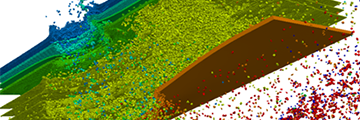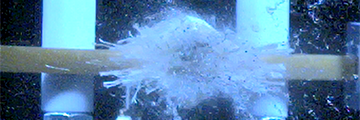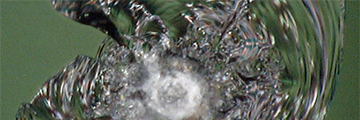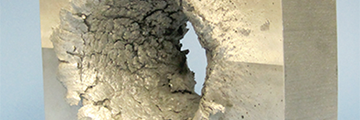







 Risk Assessment
Risk Assessment
HVIT has developed multiple tools that can determine where possible risks are located
on a spacecraft so that shielding solutions can be applied to those specific areas.
 Shield Development
Shield Development
Meteoroid and orbital debris make traversing outer space very challenging, hence
advanced shielding is needed to make sure that spacecraft (and astronauts) are
safe and protected from possible hazards.
 HyperVelocity Testing
HyperVelocity Testing
There's only one way to really know how a shield is really going to work –
test it! Real-world experiments are used to develop mathematical
algorithms that determine how much damage a shield can handle before it fails.
 Impact Videos
Impact Videos
Want so see what happens when a piece of space junk hits
a spacecraft at 4 miles per second? Of course you do!
 Impact Images
Impact Images
Evidence of in-orbit meteoroid and orbital debris impacts
taken from the ISS, Space Shuttle and other spacecraft.
 Reference Documents
Reference Documents
Take a dive into our in-depth research and learn more about
what it takes in order to exist in the realms of outer space.
The Issue
Inspections of space-flown hardware clearly show evidence of numerous impacts by
small, high-speed particles. Thousands of impacts were observed on the Space Shuttle
orbiter fleet. Returned hardware from the International Space Station (ISS) as well
as pictures of the exterior of ISS show evidence of thousands of these impacts. All
spacecraft get impacts, but fortunately, most of these are small.
There are two types of impactors. The first type is the naturally-occurring
"micrometeoroid" particle. The second type is the "orbital debris" particle.
Collectively, these are known as "MMOD."
While they may seem like the same threat, they are not. The meteoroid particles
orbit the Sun, can have higher impact speeds but are also generally less dense than
orbital debris. Orbital debris particles orbit the Earth, are slower but generally
have higher densities than meteoroid particles and can be very damaging. Also, because
they differ in their orbit characteristics, they approach spacecraft from slightly
different directions.
Our Mission
To improve crew safety and mission success by designing spacecraft structures that
can withstand high-speed impacts of MMOD. These designs are used along with an array
of advanced analytical tools to estimate crew and spacecraft MMOD risk. Knowing which
spacecraft components drive the MMOD risk can then be used to identify mass-efficient
shielding solutions to reduce MMOD risk to an acceptable level.
The NASA Hypervelocity Impact Technology (HVIT) team has analyzed many spacecraft
and conducted thousands of hypervelocity impact tests since its inception almost
four decades ago.
The HVIT team consists of a small group of dedicated engineers, scientists, technicians,
and managers who are experts in the areas of materials science, impact physics, computer
science, chemical engineering, structural mechanics, probability and project management.
Our Capabilities
Bumper MMOD Risk Analysis:
- Spacecraft modeling
- Failure criteria development
- Ballistic Limit Equations (BLEs) development and application
- Analysis and presentation of risk results
- Identification of residual risk "hot spots"
- Prioritization of risk drivers (for risk reduction)
- Characterization of primary threat directions for each spacecraft component
Ballistic Limit Equation Verification:
- Impact Test Plan development
- Test sample preparation/build-up
- Projectile material and size selection
- Conduct test readiness review
- Test monitoring (remote or in field)
- Test data collection
- Impact test conditions
- Post-test damage measurements
- Post-test photos of each layer
- Ballistic Limit Equation updates (if necessary, based on the test data)
- Full test report with updated BLEs
Other Capabilities:
- Enhanced light-weight shielding
- Metallic-foam shielding
- MM risk assessments for near-Lunar, Mars, and near-Solar environments
- MMOD Impact Sensors:
- In-situ data collection
- Impactor Characteristics
- Velocity
- Approach direction
- Event date/time
- Mass estimate
- Self-sealing shield technology